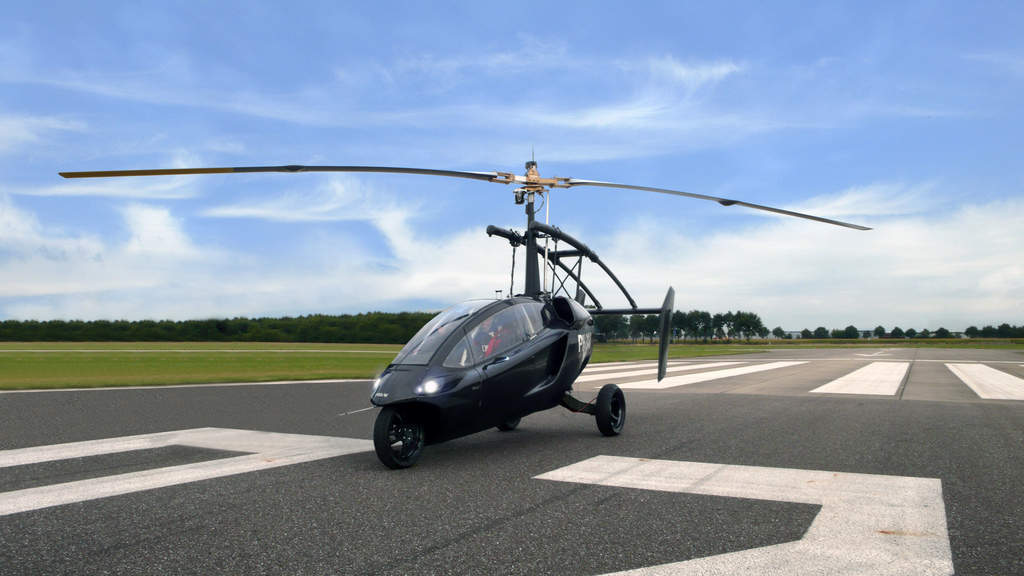
“Mark my words: a combination airplane and motorcar is coming. You may smile, but it will come,” car-maker Henry Ford reportedly predicted in 1940.
It may have taken a little longer than Ford thought it would. However, almost eight decades on, his prediction is starting to come true.
Dutch aircraft manufacturer PAL-V is debuting the Liberty, a road-capable aircraft, at the Geneva Motor Show this week.
While a questionable one, given plenty of other companies have made the same claim, the company has dubbed the PAL-V Liberty as the “world’s first flying car”.
El PAL-V Liberty hace realidad el sueño de tener un auto que vuela https://t.co/7NqFqJcfJt pic.twitter.com/tTNRX2LF9O
— Univision (@Univision) March 4, 2018
Capable of reaching speeds of up to 100 miles per hour on the ground 112 mph in the skies, PAL-V hopes to see its creation zipping through the air by 2020.
It complies with road safety regulations and has been certified by the European Aviation Safety Agency and US Federal Aviation Administration. However, buyers will require both a driving and pilot’s licence.
PAL-V seems confident that its product will be a success. It has already started taking orders on its €299,000+ flying car. Yet history suggests that the Liberty is destined to crash and burn.
A history of flying cars
1917 – Curtiss Autoplane –
The PAL-V comes a century after the first attempt to put cars in the sky. Before any attempt at creating a flying car required a tacky futuristic name and design, aircraft industry pioneer Glenn Curtiss hoped to achieve the feat by attaching wings and a propeller to a standard motorcar. Curtiss managed to get wheels off of the ground. However, the Curtiss Autoplane was never able to achieve full flight before World War I halted development.
If successful flight tests count, then the Curtiss Autoplane from 1917 was the first. pic.twitter.com/8eScSDqoAU
— Elaine Ou ? (@eiaine) February 17, 2017
1937 – Waterman Arrowbile –
American inventor Waldo Waterman’s attempt at a flying car did manage to achieve flight. Three Arrowbile cars travelled across the United States, embarking on a 2,000 mile journey from Santa Monica, California to Cleveland, Ohio. However, the Waterman vehicle was more aircraft that could be driven that car that could be flown, which did little to attract customers. As a result, Waterman only ever produced five Arrowbile flying cars.
The Waterman Arrowbile – Waldo Waterman was the first American to make a true flying car https://t.co/mPBXLThE9c pic.twitter.com/0VAjg2iyP5
— The Vintage News (@TvnVintage) April 26, 2016
1946 – Fulton Airphibian –
Created by inventor Robert Edison Fulton Jr., the Airphibian took a similar approach to the Arrowbile, creating an airplane with detachable wings, tail and propeller that transformed it into a road-safe vehicle. The Airphibian successfully took to the skies in 1946 and was the first flying car to be approved by the Civil Aviation Administration. However, financial difficulties stopped Fulton Jr. from turning the Airphibian into anything more than a prototype.
Fulton Airphibian FA-3 pic.twitter.com/C93e0uF3Lc
— Skies-of-Glory (@violetpilot1) December 2, 2015
1947 – Convair –
Following the Airphibian, aircraft manufacturer Convair returned to the idea of sticking wings on top of a car. The company produced two concepts – the 116 and 118 – both of which achieved flight. However, after the second car ran out of fuel and fell out of the sky, Convair turned its attention elsewhere.
The Convair Model 116/118 ConvAirCar was a prototype roadable aircraft. pic.twitter.com/vJ1uOenV9c
— PJ de Jong (PJ) (@jong_pj) March 31, 2015
1949 – Taylor Aerocar –
After a meeting with Fulton Jr., creator of the Airphibian, aeronautical engineer Molt Taylor came up with a concept that would cut down the time it took to convert the Airphibian from plane to car. The Aerocar featured foldable wings that Taylor hopes would make it appeal more to the public. The Aerocar was approved both to fly and drive on American highways. However, despite plenty of promise, it never entered production.
This #TravelTuesday take a moment to appreciate one of our stranger aircrafts, the Taylor Aerocar III. This roadable airplane can transform from a car to a plane in about 15 minutes. If you could transform your own car into a plane, where would you travel? https://t.co/uskWpXeMMq pic.twitter.com/PVafYCgsjl
— The Museum of Flight (@museumofflight) January 30, 2018
1958 – Volante Tri-Athodyne –
Eighteen years on from Henry Ford’s flying car claim, the manufacturer turned its attention back to the concept. However, the 1958 Ford Volante Tri-Athodyne was never anything more than that. Ford’s concept was merely a design and a working model was never actually produced. However, it did usher in that futuristic look that modern manufacturers opt for.
Ford’s flying car concept from 1958: the Ford Volante! Kinda looks like an iPod, right? #TBT pic.twitter.com/TQBpv0NbFX
— SoCalFord (@SoCaliFord) July 10, 2014
1990 – Flight Innovations Sky Commuter –
Flying cars were seemingly put on hold for a number of decades until a team of Boeing engineers quit the aviation experts to attempt to finally crack the flying car. Following up on Ford’s vision of a space-age vehicle, the Sky Commuter ditched the clip on wings, offering a vehicle that required little change to switch between land and air. The company invested millions of dollars into the development of the Sky Commuter. However, just three were created before the concept was grounded.
Boeing Sky Commuter: el carro volador, a subasta! http://t.co/m4VYjn6nUk pic.twitter.com/aLAIbl7W5B
— Autocosmos Colombia (@Autocosmos_co) July 16, 2015
2000 – SkyRider X2R –
MACRO Industries has been developing the SkyRider X2R since the early 2000s. The concept proposes an onboard voice control system that would allow the user to set a destination. Despite plans to have a working SkyRider X2R prototype ready by 2005, little has been heard about the flying car since. MACRO doesn’t seem to have shelved the project, but progress has seemingly stalled.
PAL-V’s closest competitors
Until the PAL-V Liberty launches, it is no closer to being the first flying car than any other concept in development.
Unlike PAL-V, Chinese aviation manufacturer Terrafugia claims to have made the world’s first practical flying car. The Terrafugia Transition, in development since 2006, the vehicle can perform adequately both on roads and in the air, reaching speeds of up to 100 mph. Previous flights have been successful and Terrafugia is finalising the Transition for sale. They hope to begin shipping within the next three years.
Terrafugia Transition Has Been Approved by FAA https://t.co/JF6fpYWYly pic.twitter.com/zCBUXQ9tr0
— Anam Rathor™ (@AnamRathor) July 21, 2016
AeroMobil is also giving PAL-V a run for its money. Designed by a team of 40 aviation and automotive experts, the AeroMobil will be able to transition from plane to car in three minutes. Having first left the ground in 2013, the company claims that its vehicle will be ready to ship by 2020.
Alle reden vom #Flugtaxi jetzt in Deutschland und meinen, das sei Fantasterei. Dabei hat das Start-up @aeromobil aus #Bratislava ein solches Gefährt längt zur Serienreife gebracht. #Slowakei https://t.co/Q2GlSVcT9H pic.twitter.com/36wP5yBGsl
— Gerit Schulze (@GTAI_Prag) March 6, 2018







